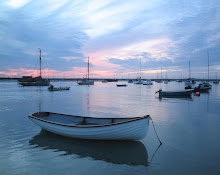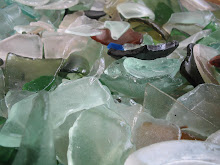So here are a few more pics from Sunday evening's stroll at East Mersea. They're not very good because the camera really is on its last legs and the light was fading. (I thought the camera had died again today, but it roused itself briefly and took a photo of my feet and the kitchen floor, just to prove to itself that it could and to prove to me how very much the floor is in need of a darned good wash.)
Anyway, here's how Mersea - along with the rest of the Essex/Suffolk/Norfolk coastline is gradually disappearing into the sea.

 This is nothing new - it's been happening for a very long time indeed. But it is still quite a shock to note exactly how much has been lost just in the 20-odd years since I first started visiting Mersea.
This is nothing new - it's been happening for a very long time indeed. But it is still quite a shock to note exactly how much has been lost just in the 20-odd years since I first started visiting Mersea.
 Things are much worse further up the coast. Historically, perhaps the most notable instance is Dunwich, a large medieval port which fell into the sea over the last millennium - a genuine Lost City under the waves. All that remains today is less than a tiny village. And it didn't happen gradually, either, but in catastrophic bursts. In a single prolonged storm in the fourteenth century, for example, 400 houses and two churches, as well as shops and windmills, were taken by the sea.
Things are much worse further up the coast. Historically, perhaps the most notable instance is Dunwich, a large medieval port which fell into the sea over the last millennium - a genuine Lost City under the waves. All that remains today is less than a tiny village. And it didn't happen gradually, either, but in catastrophic bursts. In a single prolonged storm in the fourteenth century, for example, 400 houses and two churches, as well as shops and windmills, were taken by the sea.Not only dozens of churches and chapels have disappeared at Dunwich, but also a royal palace, hospitals and of course thousands of people's homes. Naturally, many legends have arisen. The most famous of these is that if, during stormy weather, you stand on the bleak stretch of beach now covering what was once the heart of the city, you can hear the bells of the churches ringing underwater. Sailors and fishermen allegedly will not put to sea when the bells are heard, as it is said to be a sure sign of a coming storm.
I'm planning a trip to Dunwich and neighbouring Walberswick (beloved of artists, including Charles Rennie Mackintosh and Philip Wilson Steer) over the summer hols. So, with any luck (and hopefully a new camera, too), I'll post some pics of the waves beneath which the Lost City lies. Meanwhile, you can read more on this blog.

Back to Mersea, and some of the fall shown here was so new that it hadn't even been touched by the tide. Sharp clods of orange sandy soil lay scattered on the sand.
Few of the WWII pillboxes are still intact (you can see one of them here). Many, like this one, have tumbled right over the cliffs.

 Hope to be back soon with some reasonably coherent thoughts on books recently read and films recently watched.
Hope to be back soon with some reasonably coherent thoughts on books recently read and films recently watched.





















4 comments:
Do know what you mean about the end of term. Both of mine have finished now. Those pictures of the coastal erosion are scary, but also magnificent. I sometimes think when I'm gardening how little time it would take Nature to claim back everything I've scraped out.
Brilliant pictures. I don't know your part of the country at all, but it looks absolutely fascinating and I'd certainly like to take a look at Dunwich.
Jane - I've watched (from afar and in passing) the reclaimation by Nature of my former beloved White Garden, over which I laboured for many hours and years. And believe me it happens astonishingly quickly and is utterly depressing. I wish now that I had dug the whole lot up and moved it wholesale!
Martin - you'll certainly have to come over this side of the country and do some background research one day. There is already much folklore and many ghost stories attached to Dunwich - but you never know, there might also be a medieval murder mystery lying there too, just waiting for you to dredge it up and use it.
Best, freshest fish and chips in all of England, Laura's Tea Shop in Dunwich. Also the desserts are devine. Just came back from London in May. Worst fish and chips ever in London. I do love England.
Post a Comment